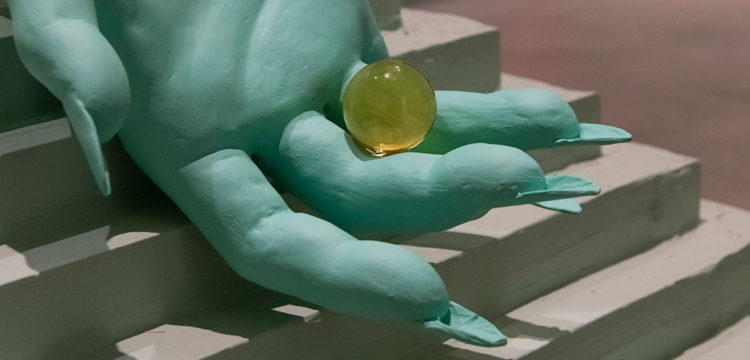The Un-subject
Guerrilla against the unceasing hostilities of the living—Part #1
The Institute of Things to Come is a yearly art programme aimed at investigating forms of imaginative speculation as cultural strategies and methodologies for critical positions, founded in 2017 by curator Valerio Del Baglivo. Its current 2020 program, entitled The convention of restorative anatomy and prosopopeia questions the categories of alterity in opposition to current politics of sovereignty, national belonging, and heteronormative approaches in Europe and beyond.
Along these lines of research, The Institute started a collaboration with NERO and invited curator Michele Bertolino to publish a series of texts all along 2020. Derived from conversations with experts in zombie studies, queer theorists, post-porn productions and anticapitalist imaginaries, this essay discusses the figure of the zombie as critical entity, material paradox and oxymorical body.
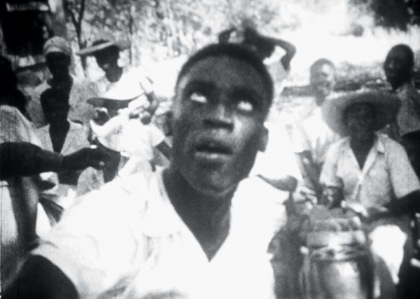
“Each new wave of zombies was beaten down and killed by the living, who found them to be an irritating and irksome reminder of their own inescapable mortality, not to mention an echo of their own somnambulistic, conformist behavior. But the few zombies who survived annihilation managed to pass on the intelligence they had acquired to subsequent generations, perhaps through some strange telepathy only shared by the dead… or perhaps by a kind of clandestine guerrilla activity born out of resistance against the violent and unceasing hostilities of the living. Still others say it was, and always had been, just a metaphor.”
Talking about a zombies’ apocalypse, during the COVID-19 pandemic, could be either bold or naive, speculative or realistic, academic or unexpectedly pragmatical. It has been said that zombies walk among us and they, of course, enrich our wildest monstrous and dreamy utopias by revealing our ultimate fears and unbelievable hopes. Zombies could be our reflection in the mirror of the herstory or analogies for the present time, as it crumbles under our feet.
Historically the figure of the zombie has been tied with capitalism and colonialism, slavery and slave rebellion, contagion and world epidemics. Its herstory traces back to the trade of african slaves and the haitian voodoo practices. The earliest zombies were products of sorcery, victims raised from the dead by Voodoo priests to work for free—mostly in plantations. Lacking identity and consciousness, they are under their master’s control, representing the slaves’ nightmares—corpses sentenced for eternity to the exploitation of human labor. Yet, they possessed the capacity to awaken and wreck their bondages: «fanatic and insensate hordes of blacks rose as a single body to overwhelm the more “rational” white troops.» Thus the zombie served both as a powerless and powerful being, it «represents, responds to and mystifies fear of slavery, collusion with it and rebellion against it» (Elizabeth McAlister in Zombie Theory: A Reader). The zombie was first brought to western attention during the US Occupation of Haiti (1915-1934). As a colonial transplant, it enters the US narratives through an exoticization and depreciation of the black body, setting up neocolonial, racial and economical implications. Among those, the absence of copyright issues allowed for a profound proliferation of zombie narratives, going beyond property rights, and quite drastically changing the anatomy and physiology of the creature itself. Hollywood transformed the black-haitian slaves into the white consumer: the whitewashed zombie was set to discuss whiteness, forgetting its own roots. Because of its relationship with the death instinct and the depiction of consumerism it has become the only modern myth of the capitalist era. Still, it shares a statement with its ancestors: the monstruouse corpse is “a critique of the inhuman and unnatural peculiar institution” (Sarah Juliet Lauro in Zombie Theory: A Reader) which is constantly at stake.
In uncertain times, when loss and annihilation are everyday companions, zombies might jeopardize our imaginary by proposing a world in which individuality and subjectivity have disappeared, in which each being stands for its contingency, embracing its negativity. Yet, they may disrupt our linear conception of time, compelling an adhesion to the queer and now. Zombies could teach us how to dissolve ourselves in the jouissance and rise again.
Slave and slave-rebellion
When I begun to develop this project—as part of The Convention of restorative anatomy and prosopopeia, the 2020 programme of The institute of things to come—I had just finished Jim Jarmusch’s latest movie, The Dead Don’t Die. Some old-school zombies raise from their tombs after the “polar fracking”—a technological operation pursued by the US republican government to give perpetual energy to the economic productive system—altered Earth’s rotation. They haunt the city of Centerville, limping around and calling out for what they crave: Wi-Fi, Chardonnay, Siri, Xanax. Obviously, they also eat the living. The only ones left alive are the outsiders: some teens in jail and Bob, a hermit who accepts solitude as a moral stance, commenting from afar his visions «of people reduced to the state of loveless, lonely consumers.»
Jarmusch collects all genre topoi. First, zombies are reversed images of humans: bodies without a mind, subhumans instead of conscious agents; slaves without agency instead of ambitious characters. Yet, humans and zombies share a common enslavement: a drive towards consumerism – which happens to be productive only in one case, that of the zombies’. Zombies also inadvertently result from human actions, as if human technology exceeded the natural domain endangering the planet, which in return protects itself.
Through images, Jarmusch sums up theoretical issues discussed by scholars in zombie theory. Sarah Juliet Lauro may be one of the most renown and prolific among those. She approaches zombies from a herstorical and critical point of view, looking specifically through an anticapitalistic and posthuman lens. I took her guidance in order to decode and frame some initial thoughts, that set the stage for the whole Guerrilla against the unceasing hostilities of the living project. In A Zombie Manifesto. The non-human Condition in the Era of Advanced Capitalism (2008) written with Karen Embry, she acutely identifies the zombie with a post-object/subject being, paving the way for a reconceptualization of the individual. I thought this would be a perfect starting point.
Our conversation, set to happen a few months ago, finally took place in April 2020. At the beginning of the “end of the world”, we found ourselves examining apocalyptic scenarios. We were reluctant at the beginning; yet, we were conscious of the relevance of the topic, which might be able to create a fertile ground where to grow and offer practical strategies for survival.
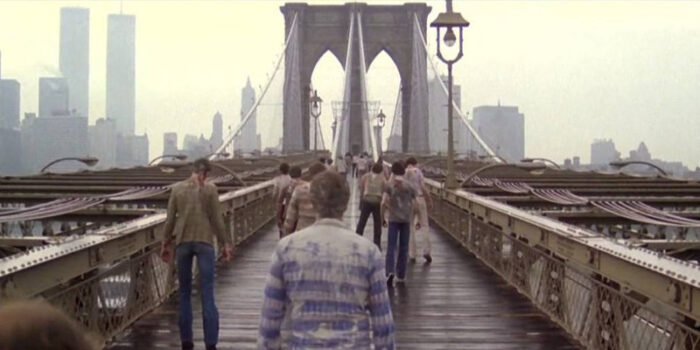
“I do believe the zombie is both slavery and slave-rebellion, a boundary figure. Its paradoxical potential has captured the Western imagination” – she says. “Its irreconcilable body (both living and dead) shows the impossibility to divorce the aforementioned categories. They sustain each other, even when we consider, for example, the specific kind of the ‘viral zombie’ – which results from being infected by a virus. I’m touching very sensitive material, considering what is happening around us now. Yet, if we look at the physiology of the virus it is quite clear: a virus is taking over the cells and it reprograms them to reproduce itself. It is a sort of enslavement.” Similar to the one acted upon dead-men by a witch-doctor to exploit their labour, I would add. “So even in recent narratives, slavery is at the center of the play. Yet, this unremovable dialectic is what is of interest. In being neither living nor dead, neither slave nor master, the zombie presents a negative dialectic, which cannot be reconciled. The zombie has a neither/nor status”.
She sets clear guidelines. On the one hand the monster faces us, revealing our inner fears—we are enslaved to our body thereby already condemned to the grave—on the other it exceeds those boundaries: zombies emphasize our limits by grotesquely breaking them. It is an inherently negative duality. “The zombie body is a multiplicity. It raises the insufficiency of the subject/object dialectic, being living while being a corpse”—she adds.
Of course, zombies’ narratives play with it. Alongside the fear of losing one’s own body, the zombie poses a threat to consciousness, revealing the fear to lose the self. “Here comes the turning point, the zombie exposes that humanity is defined by cognizance” – Sarah Juliet Lauro comments. “It consumes the stable subject and object categories since it represents a paradox, occupying simultaneously both positions. It goes beyond the human, being the darker figure of the posthuman. Thereby it dismantles the very foundations of the capitalistic system”.
A paradoxical body: the death of the subject
Yet, one may argue that the subject has already disappeared or is already dead when the zombies eat it. Zombies have been widely linked to capitalism: both alienated workers—machines’ appendages—and compulsive consumers—whose very dreams and desires are shaped by Amazon’s or Pinterest’s algorithms—might be described as zombified. As Horkheimer and Adorno discuss, the rational mind (the I think) serves as an ideological control tool in contemporary economic apparatus and the self dissolves becoming merely a discipline device. «In the bourgeoise economy—they comment—the social work of each individual is mediated by the principle of the self; for some this labor is supposed to yield increased capital, for others the strength for extra work.» Cognitive capitalism does not eschew such a logic rather it exacerbates it: immaterial labor represents a colonization of the brain and the nervous system. The economy of presence—e.g. Instagram and social media—display aptly such stances while intensifying them. The self as a control device is continually consumed and re-produced: «when the processes of subjectivation—online, in work, in cultural participation—are hooked up to incessant self-representation» and individual experiences are rendered commodities, «self-consumption is at the order of the day».
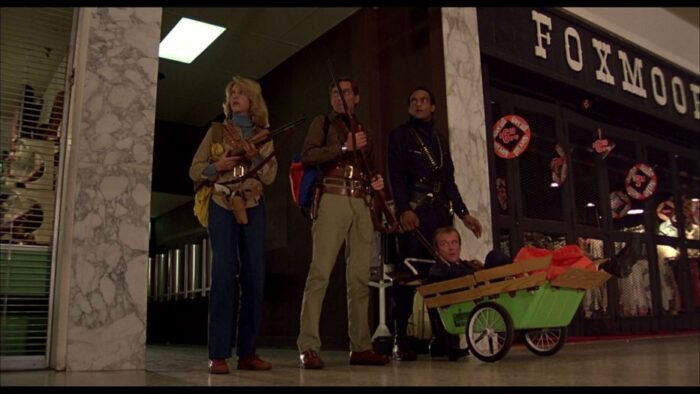
“Yet, identifying such conflation is not enough” comments Sarah Juliet Lauro, addressing the zombie’s theoretical edge, its negative power. “The zombie renders the subject/object divide ineffective, thereby annulling any thingification of the subject or any subjectification of the object.” Rather, zombies argue for an apocalypse: “the zombie’s negative essence disrupts the individual in the postindustrial, post-Holocaust era. It is an end. A destruction. It is inherently anti-cathartic because its dialectic never synthesises a common term. The zombie is never going to be a positive model of what could await us. Yet, it is the grey zone we have to get through to be truly post-capitalistic. It is an unresolvable post-human figure, for it is wiping out the very essence and definition of humanity.”
The zombie can be compared with Haraway’s cyborg, which dismantles the individual subject by addressing hybridity. The cyborg expands, both subject and object, female and male, natural and artificial. “Yet, even if it disrupts the human by creating human-object compositions, the both/and mode still holds subjectivities” Lauro comments. “On the one hand the cyborg holds a more promising futuristic utopia—one that is already around us. But it involves a discursive transformation, requiring an act of volition, an intentionality. It needs a self-recognition, thereby insisting on the subject again. The zombie is the darker-goth brother: it is the anti-subject that cannot recognize itself as so. It is destruction.”
A paradoxical body: a revolutionary assemblage?
Even if Lauro stresses the unresolvable negativity of the zombie—its posthuman posture that paves the way for the post-capitalistic time—I wonder whether we can still excavate some useful concepts or if we can still build a revolutionary practice out of it.
Lauro clarifies this idea once more: “Posthumanism dates back to Deleuze and Guattari’s figure of the schizophrenic—whom is still considered as a subject, but is highlighted in its multiplicity, stimulating post-individual thinking. On the other hand, the zombie is pure drive. It simply consumes and its reproduction happens as an unforeseen result. It is an all-contagious and all-consuming being. It is not something we can actually aspire to, neither on the singular level nor on the collective domain. In World War Z (Marc Forster, 2013), the zombies constitute a monstrous deformation of what a collective could be. They do not suggest some hopeful gestures, rather they are moved by mere contagion and destruction”.
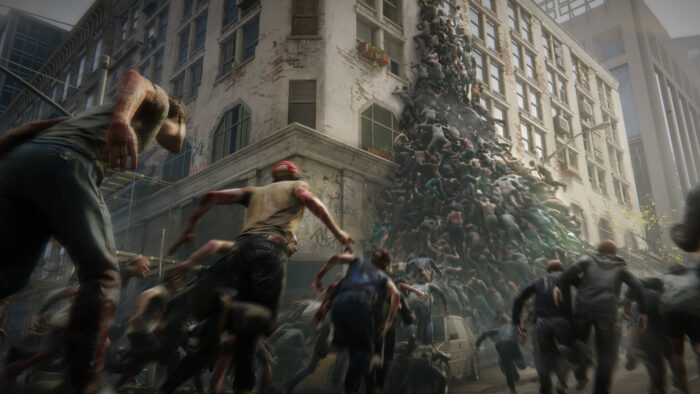
In other words, the zombie has no agency. It cannot think, act, move in the way we currently conceive these terms. Its paradoxical constitution, that dismantles any system of reason, is only destruens both on the conceptual and on the material level. “Take a zombie” she explains. “It literally is a body infected with gangrene – dead and alive tissue altogether. Is there some kind of positive message in that? I don’t know. I do believe the zombie is a game changer, yet it projects a nightmarish scenario, in that the zombie just points to the ever-present threat to the human body, a continuous decaying.” However, the story does not end here. Lauro points out how such destruction of the subject/object divide, which is compelled by the zombie ontology, can prevent any reconceptualization of individuality – thereby dismantling the subject. The zombie is a gatekeeper, it represents a transition. Yet, it is not a model. “The aim is to develop a collective thought, we must think at the level of the horde, the swarm, the mob. There lies a new individuality, which cannot be individual. Nevertheless, zombies cannot represent such collectivity for they cannot think” Lauro concludes. Recent events may provide some hints, she believes: “Consider the US. After the COVID-19 spread, some republicans started barfing things like ‘I would rather die than kill the country.’ Donald Trump echoed, by stating that the cure cannot be worse than the problem. They are creating a paradox, asking the people to subjugate to a collectivity which in turn is mastered by the stock market—the only individuality that finally has the right to exist. Capitalism is ingesting itself, as in one of Aimee Bender’s story in which a zombie starts feeding on its own body.” In her words, capitalism puts forward a fictitious collective subject, asking for a sacrifice in light of an abstract ideal. “Luckily, people are starting to realize the craziness. Thus, ascending beyond the individual becomes more than just a pragmatic hint, it becomes effective. People are doing it in the service of other people. However, it is not a zombie horde, which, as said, cannot think, act or move. It looks more like what happens when the subject is dead. It is a marxist revolutionary collective, a concrete universal” Lauro concludes.
To sum up, Lauro points to the paradoxical body of the zombie, whose very nature dismantles any rational discourse on subjectivity and individuality. Yet, even if the zombie buries the subject, what will rise after should not be assimilated with such a paradoxical nature. Here, I find myself disagreeing to some extent, even partaking the starting points. I still wondered if such concrete universal can be identified with the zombie horde, if its paradoxical and unthinkable structure can draft some hints on how to rethink bodies, political agencies and revolutionary assemblages. In the end, I do believe zombies could help us in redefining and reclaiming corporeality.

A paradoxical body: some hints
Guerrilla against the unceasing hostilities of the living aims at describing some pragmatical tools. I believe that, even at this early stage, we are already able to give several hints.
In being intermeshed with dead and alive tissue, asserting a paradoxical biology, in being host for no subjectivity, erasing hierarchies and dualism—as Lauro has acutely explained—the zombie body may be transcorporeal. Philosopher Stacy Aimo drafts the notion of transcorporeality to challenge western individualism transcendence and to relocate embodiment and situated knowledge: being transcorporeal means assuming a transversal posture, it means being porous. Transcorporeal entities are always entangled with the “stuff of the world”, «with the dynamic, material world, which crosses through them, transforms them, and is informed by them.» Dwelling from material feminism, posthumanism, ecology, anticapitalism, physiological and biological thinking, transcorporeality not only gets rid of the subject’s position but highlights the permeability of the body’s boundaries.
Jeffrey Jerome Cohen expands the concept, commenting on Alaimo’s and Graham’s ontologies. He argues for a zombie–oriented–ontology (ZOO) in which the concept of material transcorporeality meshes with a nonanthropocentric philosophy that assigns agency, autonomy and mystery to things. The body, as a thing, holds its obscurity and unintelligibility, asserting its presence. Therefore the zombie represents the inhuman (non human) reality of the body which beholds – as Cohen states – «our own viscerality, our own material composition.»
Zombies’ corporeality might offer new utopian scenarios, which exceed the rational–I think domain. In contrast with Lauro’s final remarks, zombies’ inability to think may reveal the final victory of the sensuous, the triumph of materiality and the emancipation of the flesh. Zombies help in trying to develop a new praxis, redefining nets and relations within the world, asserting transversal and porous located posture. Moreover, such porosity—which deals with materiality only—assembles a collective body. Zombies’ «emancipatory struggles entail monstrous claims of the body against the abstracting powers of capital» (David McNally in Zombie Theory: A Reader)
Bifo Berardi argues that COVID-19 generated a lack of body, which freezed capitalism. It is the body as a biological function that caused the current situation. It can, in turn, ignite a revolutionary agency. Quarantine acts as a reset and rebooting humanity will lead to unforeseeable futures. Now, though it may seem cynical, the transformation awaits and the zombie may just be behind that door.



